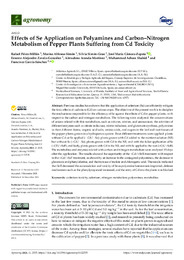Please use this identifier to cite or link to this item:
https://hdl.handle.net/11000/33471Full metadata record
| DC Field | Value | Language |
|---|---|---|
| dc.contributor.author | Pérez-Millán, Rafael | - |
| dc.contributor.author | Alfosea Simón, Marina | - |
| dc.contributor.author | Simon Grao, Silvia | - |
| dc.contributor.author | Cámara-Zapata, José-María | - |
| dc.contributor.author | Zavala Gonzalez, Ernesto Alejandro | - |
| dc.contributor.author | Aranda-Martinez, Almudena | - |
| dc.contributor.author | Shahid, Muhammad Adnan | - |
| dc.contributor.author | Garcia-Sanchez, Francisco | - |
| dc.contributor.other | Departamentos de la UMH::Física Aplicada | es_ES |
| dc.date.accessioned | 2024-10-11T12:17:06Z | - |
| dc.date.available | 2024-10-11T12:17:06Z | - |
| dc.date.created | 2021-12-14 | - |
| dc.identifier.citation | Agronomy 2021, 11(12) | es_ES |
| dc.identifier.issn | 2073-4395 | - |
| dc.identifier.uri | https://hdl.handle.net/11000/33471 | - |
| dc.description.abstract | Previous studies have shown that the application of selenium (Se) can efficiently mitigate the toxic effects of cadmium (Cd) on various crops. The objective of the present work is to decipher the mechanisms responsible for the efficiency of Se against the effects of Cd in pepper plants, with respect to the carbon and nitrogen metabolism. The following were analyzed: the concentrations of anions related with this metabolism, such as nitrates, nitrites, and ammonium, the activities of different enzymes such as nitrate reductase, nitrite reductase, and glutamate synthase, polyamines in their different forms, organic acid salts, amino acids, and sugars in the leaf and root tissues of the pepper plants grown in a hydroponics system. Four different treatments were applied: plants without Cd or Se applied (−Cd/−Se); plants grown with Cd added to the nutrient solution (NS) but without Se (+Cd/−Se); plants grown with Cd in the NS, and with the foliar application of Se (+CD/+SeF); and lastly, plants grown with Cd in the NS, and with Se applied to the root (+Cd/+SeR). The metabolites and enzymes related with carbon and nitrogen metabolism were analyzed 15 days after the application. The results showed the superiority of the +Cd/+SeR treatment with respect to the +Cd/+SeF treatment, as shown by an increase in the conjugated polyamines, the decrease in glutamate and phenylalanine, and the increase of malate and chlorogenic acid. The results indicated that SeR decreased the accumulation and toxicity of Se as polyamine homeostasis improved, defense mechanisms such as the phenylpropanoid increased, and the entry of Cd into the plants was blocked | es_ES |
| dc.format | application/pdf | es_ES |
| dc.format.extent | 18 | es_ES |
| dc.language.iso | eng | es_ES |
| dc.publisher | MDPI | es_ES |
| dc.rights | info:eu-repo/semantics/openAccess | es_ES |
| dc.rights | Attribution-NonCommercial-NoDerivatives 4.0 Internacional | * |
| dc.rights.uri | http://creativecommons.org/licenses/by-nc-nd/4.0/ | * |
| dc.subject | Cadmium toxicity | es_ES |
| dc.subject | Selenium | es_ES |
| dc.subject | Nitrogen metabolism | es_ES |
| dc.subject | Polyamines | es_ES |
| dc.subject | Metabolites | es_ES |
| dc.title | Effects of Se Application on Polyamines and Carbon–Nitrogen Metabolism of Pepper Plants Suffering from Cd Toxicity | es_ES |
| dc.type | info:eu-repo/semantics/article | es_ES |
| dc.relation.publisherversion | https://doi.org/10.3390/agronomy11122535 | es_ES |

View/Open:
Effects of Se application on polyamines and carbon-nitrogen metabolism of pepper plants suffering from Cd toxicity.pdf
15,97 MB
Adobe PDF
Share:
.png)
